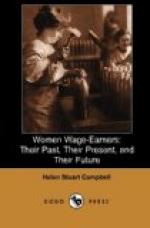A comprehensive law, promulgated Nov. 2, 1892, and regulating the labor of women and children in factories and mines, was amended in May, 1893, by the addition of very specific regulations as to all employments affecting health and morals. The Presidential decree consists of two parts,—the first dealing with the employment of women and children in connection with machinery when in motion, or in which the dangerous parts are not fully protected, in glass-blowing and in carrying weights. The second part of the decree consists of three tables, of which A enumerates certain industries, chiefly the manufacture of acids, dyes, chemicals, etc., also manures and glass, crystal, and metal polishing, in which female and child labor are prohibited; B those in which children under eighteen must not work, chiefly the manufacture of explosives; and C, a large variety of other industries in which female and child labor is only allowed conditionally. The great majority of these are industries involving special risk through the disengagement of dust-particles or vapors; while a few are ranked as dangerous, owing to risk of fire and the contraction of special diseases, etc.
Belgium, French in feeling and in methods, has known some of the worst abuses discoverable on continental soil, thousands of women and children in her mines having toiled from twelve to sixteen hours a day, with often no Sunday rest, for a wage at bare subsistence point. In “Germinal,” Zola, who spent months observing every phase of their life, has given a picture, unsurpassed in any literature, of the misery and degradation of the worker. An investigation in 1874, and indignation at some of the conditions then discovered, brought about modifications of the law. That of the general congress of 1891 accomplished much more; but work must still be done before any very marked advance becomes discernible.




